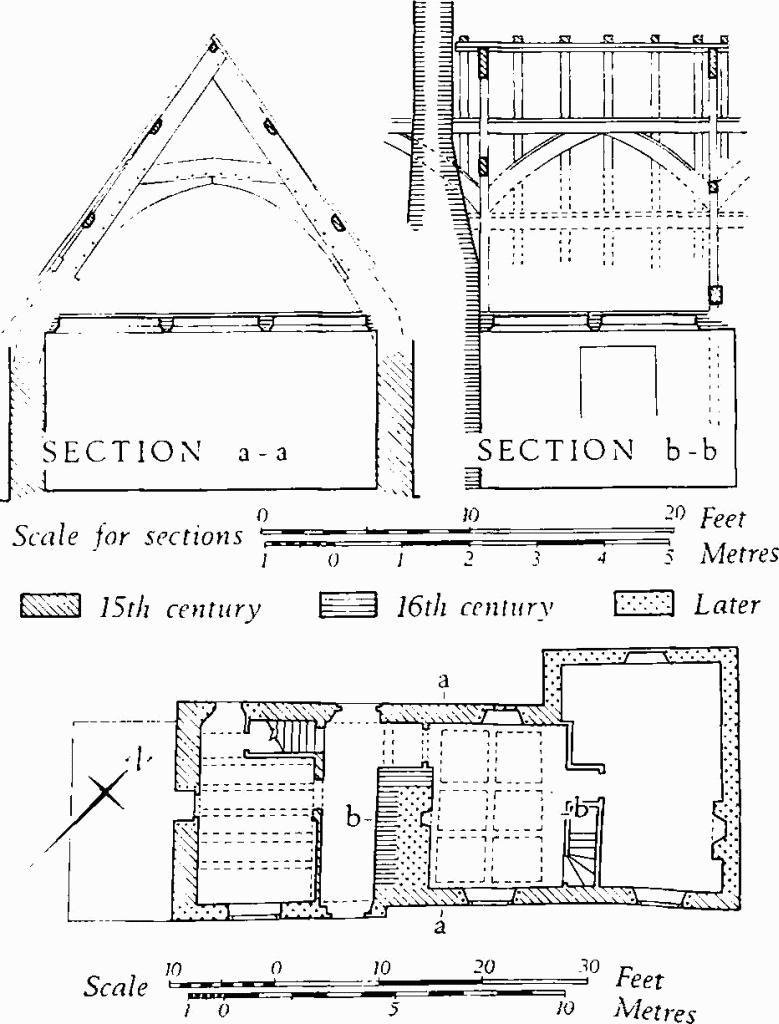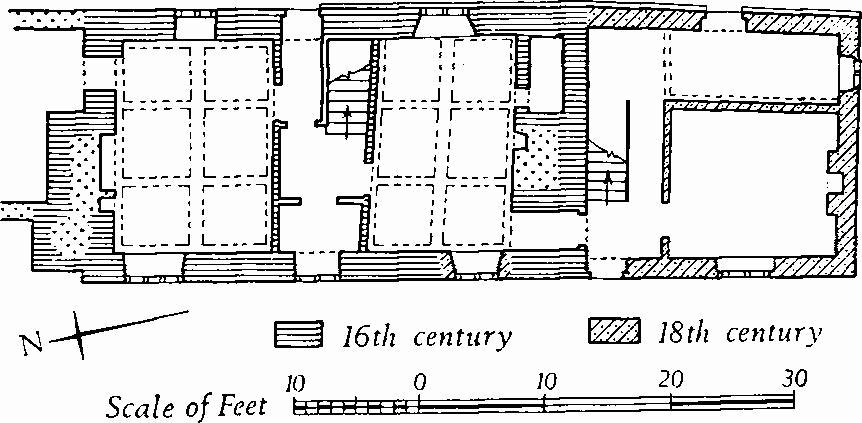An Inventory of the Historical Monuments in Dorset, Volume 4, North. Originally published by Her Majesty's Stationery Office, London, 1972.
This free content was digitised by double rekeying. All rights reserved.
'Margaret Marsh', in An Inventory of the Historical Monuments in Dorset, Volume 4, North(London, 1972), British History Online https://prod.british-history.ac.uk/rchme/dorset/vol4/pp45-47 [accessed 30 January 2025].
'Margaret Marsh', in An Inventory of the Historical Monuments in Dorset, Volume 4, North(London, 1972), British History Online, accessed January 30, 2025, https://prod.british-history.ac.uk/rchme/dorset/vol4/pp45-47.
"Margaret Marsh". An Inventory of the Historical Monuments in Dorset, Volume 4, North. (London, 1972), British History Online. Web. 30 January 2025. https://prod.british-history.ac.uk/rchme/dorset/vol4/pp45-47.
In this section
16 MARGARET MARSH (8218)
(O.S. 6 ins., ST 81 NW, ST 82 SW)
This parish, barely 550 acres in extent, comprises two roughly triangular areas joined at a narrow neck. The land is all Kimmeridge Clay, between 150 ft. and 230 ft. above sea-level; it drains into a small rivulet which flows S.W. to join the Key Brook on the S.W. boundary. The S.W. triangular area, formerly a parochial chapelry of Iwerne Minster, is probably mentioned in a document of 1310 (Hutchins III, 556). The smaller N.E. triangle, Gore Farm, once part of St. James's parish, Shaftesbury, was recorded in 1282 (Fägersten, 42).
Ecclesiastical
(1) The Parish Church of St. Margaret has walls of ashlar and rubble and tile-covered roofs. The Chancel, Nave and South Porch were rebuilt in 1872. The West Tower dates from the 15th century.
Architectural Description—The West Tower is of ashlar and has a moulded plinth, three stages defined by moulded, weathered and hollow-chamfered string-courses, and an embattled parapet with a moulded coping. The corners of the lower stages have diagonal buttresses with weathered offsets at the level of the string-courses; the top stage has plain corner pilasters, perhaps originally with pinnacles, now gone. An octagonal vice turret occupies the E. part of the N. wall and is staged in correspondence with the main stages; beside the turret the top string-course has a gargoyle. The tower arch is two-centred and of two chamfered orders with continuous jambs. The doorway to the vice has a chamfered four-centred head and chamfered jambs. The W. doorway has a four-centred head of two chamfered orders under a moulded label, and continuous jambs; above, the W. window is of three trefoil ogee-headed lights under vertical tracery in a two-centred head. The string-course between the two lower stages of the tower forms a label over the window. In the second stage, the S. wall of the tower has a window of two trefoil-headed lights with vertical tracery in a two-centred head; the lights are closed by stone slabs with lozenge perforation. The belfry in the third stage has, in each wall, a window uniform with that in the second stage.
Fittings—Chest: of cast-iron, inscribed 'Margaret Marsh register chest, John Scammell, 1813, C.W.'. Font: with round bowl, hollow-chamfered and roll-moulded below, on plain cylindrical shaft, and with base as for a Tuscan column; bowl c. 1300, base 18th century. Glass: reset in W. window, fragments including crown, fleurs-de-lis, and black-letter inscription 'Margaret' and '. . . Yong' qui hanc fenestra' mill'imo qui'ge'tesimo xli'; 15th and 16th century. Graffiti: on responds of tower arch, initials and dates, 1696 and later.
Monuments: In churchyard, on E. wall of S. porch, (1) of William Bennett, 1756, headstone with shield-of-arms of Bennett. Some 4 yds. S. of chancel, (2) of William Bennett, 1792, headstone similar to the foregoing. Some 10 yds. S. of porch, table-tombs with panelled sides and moulded tops: (3) of William Yetman, 1678, (4) of Lucy Fry, formerly wife of William Yetman, (5) anonymous, probably 18th century.
Plate: includes Elizabethan silver cup of similar form to that of Gillingham, but smaller, with maker's mark, four lozenges arranged lozenge-wise, and italic inscription 'This Plate Belong to Margrit Mash Church'.
Secular
(2) Church Farm (82371867), house, with walls of squared rubble and with tiled roofs, is of the 16th century and was originally single-storeyed with an attic, but it was heightened to two storeys, probably in the 18th century. The S. range has two rooms with hollow-chamfered intersecting ceiling beams; originally they were separated by a through-passage, but the W. partition has been removed. The W. room appears always to have been unheated; the E. room has a blocked open fireplace. The N. range has hollow-chamfered beams with shouldered stops, and the N. room, no doubt the kitchen, has a blocked open fireplace. An oven formerly projected from the N. wall, but the projection has been removed and the cavity has been filled in. It is probable that a staircase formerly occupied one of the spaces beside the N. fireplace, but nothing is seen of it today. The W. wall of the N. range appears to have been rebuilt.

Church Farm
(3) Marsh Farm (82141894), house, of two storeys with an attic, has rubble walls and thatched and tiled roofs. The original range is of the 17th century, and there are 19th-century additions on the W. and S. The three-light first-floor window in the gabled N. wall is original; other windows are of the 18th century. The exposed parts of the S. and W. walls in the original range have chamfered first-floor stringcourses. Inside, a stop-chamfered beam is exposed in the S. room of the original range.
(4) Higher Farm (82621902), house, of two storeys with rubble walls and thatched roofs, is of 15th-century origin. Many of the original roof timbers remain in situ, masked by the present roof, which is superimposed. From details of the timbers the original plan of the house can be deduced; it comprised a two-bay hall, open to the roof, a two-storeyed service bay on the S.W., and another bay on the N.E. In the 16th century the hall was chambered over and an open fireplace and chimney-stack were built in the S.W. bay, leaving the S.W. end of the former hall as a through-passage. To the S.W. of the 16th-century chimney-stack the roof has been rebuilt. All windows have been renewed. The N.E. bay has been rearranged and retains no old features; its widening on the N.W. certainly is not original.
Inside, the inserted 16th-century floor rests on intersecting beams with deep, slightly hollowed chamfers; the first floor over the kitchen rests on large joists, square in section, perhaps original. The fireplace inserted in the hall has been blocked up; there is no fireplace in the chamber above. The accompanying drawing shows the original roof members, but omits the present roof; there are indications that the principals are crucks, but they cannot now be traced below first-floor level. An open truss with arched braces spanned the hall, and a truss corresponding with the N.E. end of the hall was closed with studding. The principals supported two chamfered purlins on each side, with curved windbracing. Above the present first-floor ceilings the roof timbers are encrusted with soot, showing that originally there was an open hearth; in part of the roof an original wattle lining is attached to the underside of the common rafters.

Higher Farm
(5) Jopp's Farm (82751953), house, with walls of rubble and ashlar and with a thatched roof, is of the early 17th century. The plan, formerly of class F, has been altered by the removal of partitions and the insertion of a staircase. The N., E. and W. elevations have stone windows of three square-headed lights with recessed and hollow-chamfered surrounds; the gabled S. wall retains a small loop with two round-headed openings lighting a newel stair on the W. side of the S. chimney-stack. Inside, the large central fireplace has ashlar jambs and a chamfered timber bressummer; the S. fireplace is similar, but smaller. On the first floor, the S. chimney-stack serves a small fireplace with a four-centred head. Several stop-chamfered beams are exposed. Plank-and-muntin partitions, now dismantled, had muntins with moulded edges. A scratching on one of the ashlar window-sills includes the date 1647.
(6) Margaret Marsh Farm (81931934), house, of two storeys with rubble walls and a modern slated roof, dates from the early 17th century. Inside, the N. ground-floor room has a nine-panel ceiling with chamfered intersecting beams. Several rooms on the first floor retain original oak panelling. In the N. chamber a modern fireplace surround incorporates 17th-century oak pilasters carved with male and female figures; they spring from strapwork pedestals and support crude Ionic capitals.

Margaret Marsh Farm
(7) Gore Farm (83442056), house, now of two storeys but originally single-storeyed with attics, has squared rubble walls and tiled and slated roofs (Plate 31). It dates from the 16th century and was heightened and enlarged on the S. probably in the 18th century. The continuous footing courses suggest that the S. bay occupies the site of an original building. Inside, the surviving original range has a plan of class T. The rooms have heavy and elaborately moulded oak main beams and wall-plates, and moulded cross-beams. The open fireplaces are blocked; externally, the N. fireplace has a large chimneybreast with four weathered offsets; the adjacent oven has a lean-to roof.

Gore Farm
